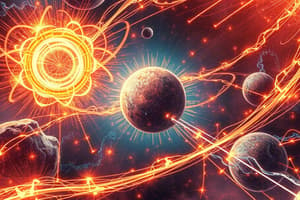Podcast
Questions and Answers
What does Newton's 2nd Law of Motion state?
What does Newton's 2nd Law of Motion state?
- Net force equals mass times acceleration. (correct)
- An object at rest stays at rest unless acted upon by a net force.
- Energy cannot be created or destroyed.
- For every action, there is an equal and opposite reaction.
Which of the following describes kinetic energy?
Which of the following describes kinetic energy?
- KE = mgh
- KE = 1/2 mv² (correct)
- KE is energy stored in an object due to its height.
- KE is the energy transferred during heat conduction.
What is the main principle of the 1st Law of Thermodynamics?
What is the main principle of the 1st Law of Thermodynamics?
- Heat flows from cold to hot.
- Entropy increases over time.
- Energy conservation in closed systems. (correct)
- Energy can be created in closed systems.
Which of the following correctly distinguishes between mechanical and electromagnetic waves?
Which of the following correctly distinguishes between mechanical and electromagnetic waves?
Ohm's Law relates which three quantities?
Ohm's Law relates which three quantities?
What concept does the equation E=mc² relate to?
What concept does the equation E=mc² relate to?
Which statement is true regarding the four fundamental forces?
Which statement is true regarding the four fundamental forces?
What role does physics play in engineering?
What role does physics play in engineering?
Flashcards are hidden until you start studying
Study Notes
Key Concepts in Physics
1. Mechanics
-
Newton's Laws of Motion
- 1st Law: Inertia; an object at rest stays at rest, and an object in motion stays in motion unless acted upon by a net force.
- 2nd Law: F = ma; net force equals mass times acceleration.
- 3rd Law: Action-reaction; for every action, there is an equal and opposite reaction.
-
Kinematics
- Describes motion without considering its causes.
- Key equations relate distance, velocity, acceleration, and time.
-
Dynamics
- Study of forces and their effects on motion.
- Includes concepts of friction, tension, and gravity.
2. Energy
-
Kinetic Energy (KE)
- KE = 1/2 mv² (m = mass, v = velocity).
-
Potential Energy (PE)
- Gravitational PE = mgh (m = mass, g = gravitational acceleration, h = height).
-
Conservation of Energy
- Energy cannot be created or destroyed; it can only be transformed from one form to another.
3. Thermodynamics
-
Laws of Thermodynamics
- 1st Law: Energy conservation in closed systems.
- 2nd Law: Entropy of an isolated system always increases; heat flows from hot to cold.
-
Heat Transfer
- Conduction, convection, and radiation.
4. Waves and Oscillations
-
Wave Properties
- Wavelength, frequency, amplitude, speed.
-
Types of Waves
- Mechanical (requires medium) vs. Electromagnetic (does not require medium).
-
Sound Waves
- Longitudinal waves; speed depends on medium.
5. Electricity and Magnetism
-
Ohm's Law
- V = IR (V = voltage, I = current, R = resistance).
-
Circuits
- Series and parallel circuits; total resistance and current calculations.
-
Magnetic Fields
- Produced by moving charges; affects charged particles in motion.
6. Modern Physics
-
Relativity
- Special Relativity: Time and space are relative; E=mc² (energy-mass equivalence).
-
Quantum Mechanics
- Describes behavior of particles at atomic and subatomic levels.
- Concepts include wave-particle duality and uncertainty principle.
7. Fundamental Forces
-
Four Fundamental Forces
- Gravitational, electromagnetic, strong nuclear, weak nuclear.
-
Interactions
- Govern the behavior of matter and energy in the universe.
8. Applications of Physics
-
Engineering
- Application of physics principles in designing structures, machines, and systems.
-
Technology
- Development of electronic devices, medical imaging, and renewable energy solutions.
9. Measurement and Units
-
SI Units
- Length (meter), mass (kilogram), time (second), electric current (ampere), temperature (kelvin).
-
Dimensional Analysis
- Technique for checking equations by analyzing the units involved.
Mechanics
-
Newton's Laws of Motion: Describe the relationship between a body and the forces acting upon it, leading to its motion.
- 1st Law: Objects remain in their state of motion unless acted upon by an external force (law of inertia).
- 2nd Law: The net force acting on an object equals its mass times acceleration (F = ma).
- 3rd Law: Every action has an equal and opposite reaction.
-
Kinematics: Examines motion without addressing its causes; includes equations that connect distance, velocity, acceleration, and time.
-
Dynamics: Investigates forces impacting motion, such as friction, tension, and gravitational force.
Energy
-
Kinetic Energy (KE): Defined as KE = 1/2 mv²; it is the energy an object possesses due to its motion, determined by its mass and velocity.
-
Potential Energy (PE): Gravitational potential energy is given by PE = mgh, where m equals mass, g is gravitational acceleration, and h indicates height above a reference point.
-
Conservation of Energy: States that energy cannot be created or destroyed, only transformed between different forms.
Thermodynamics
-
Laws of Thermodynamics:
- 1st Law: Conservation of energy within closed systems.
- 2nd Law: Entropy in isolated systems tends to increase; heat naturally moves from hot to cold areas.
-
Heat Transfer: Involves three mechanisms: conduction (through materials), convection (in fluids), and radiation (emission of energy in waves).
Waves and Oscillations
-
Wave Properties: Key characteristics include wavelength, frequency, amplitude, and speed.
-
Types of Waves:
- Mechanical waves require a medium to travel (e.g., sound waves).
- Electromagnetic waves do not require a medium (e.g., light).
-
Sound Waves: A type of longitudinal wave where the speed of sound depends on the medium through which it travels.
Electricity and Magnetism
-
Ohm's Law: Describes the relationship between voltage (V), current (I), and resistance (R) in a circuit, represented as V = IR.
-
Circuits:
- Series circuits have a single path for current; total resistance equals the sum of resistances.
- Parallel circuits provide multiple paths; total current equals the sum of currents through each path.
-
Magnetic Fields: Generated by moving electric charges; they influence the behavior of other charged particles in motion.
Modern Physics
-
Relativity: Special relativity revolutionizes the concepts of time and space, summarized by the equation E = mc², explaining energy-mass equivalence.
-
Quantum Mechanics: Explores particle behavior at atomic and subatomic levels, introducing principles like wave-particle duality and the uncertainty principle.
Fundamental Forces
-
Four Fundamental Forces:
- Gravitational: Attraction between masses.
- Electromagnetic: Interaction between charged particles.
- Strong nuclear: Binds protons and neutrons in the nucleus.
- Weak nuclear: Responsible for certain types of particle decay.
-
Interactions: These forces govern the interactions of matter and energy throughout the universe.
Applications of Physics
-
Engineering: Utilizes physics principles for the design and construction of structures, machines, and systems.
-
Technology: Facilitates innovation in electronic devices, medical imaging technologies, and renewable energy sources.
Measurement and Units
-
SI Units: Standard units of measurement include meter (length), kilogram (mass), second (time), ampere (electric current), and kelvin (temperature).
-
Dimensional Analysis: A method used to verify the dimensional consistency of equations, ensuring that both sides have the same units.
Studying That Suits You
Use AI to generate personalized quizzes and flashcards to suit your learning preferences.




